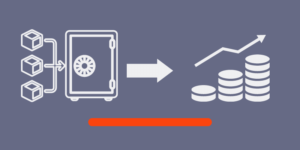How to stake crypto in NZ
Staking a cryptocurrency is a way to passively earn rewards on your investment. Our guide explains what staking is, its pros and cons, and how to stake crypto in New Zealand.

The breakdown
- Interest on investments can range from around 1% APY for stablecoins and well into double figures for smaller, less well-known coins.
- It’s not possible to stake all cryptocurrencies, but plenty of choice is still available.
- It’s possible to stake cryptocurrency through a number of exchanges available to Kiwis.
Author: Kevin McHugh, Head of Publishing at Banked.
The most common way to generate revenue with cryptocurrency is to invest and sell when (and if) its value increases. But crypto staking is an alternative method that allows investors to earn passive income.
What is crypto staking?

Staking involves pledging your crypto investment to support the activity of a blockchain network. In return for ‘staking’, you can earn rewards and interest on your crypto investment.
In this sense, it’s a little like holding money in a bank account — the longer you keep your money in the account, the greater opportunity you have for earning interest. As some crypto staking platforms have a lock-in period (typically between 30 days and a year), you could also compare staking to investing in a term deposit.
The returns from cryptocurrency staking can range from around 3-5% annual percentage yield (APY) for a well-known asset such as Ethereum and Cardano, to double figures for smaller cryptocurrencies. However, it’s essential to remember that cryptos are very volatile, and a hefty interest return will mean nothing if the currency’s value plummets.
How does it work?
Cryptocurrencies are made possible by blockchains, which are decentralised ledgers of all transactions made across a network. All transactions must be validated before being recorded on the blockchain and there are two protocols for doing this: proof of work and proof of stake.
Proof of work involves the controversial practice of crypto mining. Miners compete to solve a complicated mathematical challenge using a huge amount of computer processing power. Whoever solves it adds the next block and gets a reward for doing so.
Bitcoin uses the proof-of-work protocol and it’s estimated that 91 terawatt-hours of electricity are used annually to support the currency. That’s more than the entire country of Finland uses in the same period.
Proof-of-stake requires much less computing power to validate transactions and secure the blockchain. You pledge your currency to a protocol for the purpose of confirming transactions on the blockchain. If you are chosen at random to validate a block of transactions, new coins are minted and you are rewarded. This reward usually comes in the form of the same cryptocurrency that was staked, but that’s not always the case.
The more crypto you stake, the more likely your holdings will be chosen to validate a transaction. You continue to own the cryptocurrency at all times and you can choose to unstake it when needed. However, in some situations you must lock in your stake for a set period.
How to start cryptocurrency staking from NZ
Here are three easy steps to get you started with staking your cryptocurrency.
Select a cryptocurrency to stake
To get started, you must first choose which cryptocurrency you want to stake. As explained earlier, you can’t technically select any coin, only those that use the proof-of-stake protocol. However, some platforms will let you earn rewards on proof-of-work protocol coins, such as Bitcoin. There is still plenty of choice, however.
It’s also possible to stake stablecoins. Stablecoins are cryptocurrencies that are pegged to a fiat currency or commodity. As the name suggests, this makes them more stable and less volatile than other cryptocurrencies.
Popular cryptocurrencies used for staking include:
- Ethereum 2.0 (ETH)
- Cardano (ADA)
- Polkadot (DOT)
- Tezos (XTZ)
- Polygon (MATIC)
- Binance (BNB)
- Terra (LUNA)
- Solana (SOL)
- Tether (USDT) – a stablecoin
- USD Coin (USDC) – a stablecoin
Choose an exchange to purchase your crypto
Once you have chosen the coin you want to stake you need to purchase it. The simplest way of doing this is through an exchange or crypto retailer.
There’s a range of exchanges available to the NZ market, each with its own pros and cons. Local and Australian exchanges are typically more accessible to a New Zealand audience as they let you deposit and withdraw NZD directly and they often have local customer support.
The larger international exchanges such as Binance and Crypto.com usually don’t have these features, but they offer much greater choice regarding the number of cryptocurrencies, trading options, and more. Find out more about choosing the best crypto exchange for you in our guide, or compare options in the table below.
If you want a little more help, check out our guide on how to buy crypto in New Zealand.
| Exchange/retailer | Available crypto | Fiat currencies | Deposit options | Key fees | Promotions | Learn more |
|---|---|---|---|---|---|---|
 Binance
Binance
|
350+ | 18 (including NZD) | Credit card |
- Trading fee: Maker: 0.02-0.1%
Taker: 0.04-0.1% - Deposit fee: 3.5%-5% (minimum $10) |
None currently | Binance review |
 Easy Crypto
Easy Crypto
|
155 | NZD | Bank transfer, credit card, POLi | - 0.89% trading fee and 0.4% forex fee | None currently | |
 Swyftx
Swyftx
|
312+ | 2 (including NZD) | Bank transfer, credit card, POLi |
- Trading fee: 0.6% (high-volume trading discount) - Deposit fee: $0 |
None currently | |
 Independent Reserve
Independent Reserve
|
27 | 4 (including NZD) | Credit card |
- Trading fee: Up to to 0.5% - Deposit fee: $15 (no fee for deposits over $5,000) |
None currently | |
 Crypto.com
Crypto.com
|
250+ | 20+ (including NZD) | Credit card |
- Trading fee: Maker: 0.04-0.4%
Taker: 0.1-0.2% - Deposit fee: $0 |
None currently |
Stake your crypto
There are multi ways of staking crypto, from solo staking, to entering a staking pool, and staking through a crypto exchange.
Solo staking is the most complex option and requires the greatest investment. Most cryptocurrencies have a minimum staking amount for example, Ethereum requires a minimum stake of 32 ETH. As a solo staker, you would have to meet the minimum investment yourself.
A staking pool allows many people to pool their crypto together. This means you don’t have the meet the minimum staking requirement required to be a validator. Staking through an exchange, such as Binance, Crypto.com or Coinbase works in a similar way. If you made your crypto purchase through the same exchange, you would have the added convenience of not having to move funds between platforms.
Depending on the coin you’re staking and the exchange or pool you’ve chosen, you will have the choice to lock in your stake for a set period or choose a flexible option in which you can unstake when you like.
The flexible option may be the right choice if you need to use your coin for other purposes in the near future. However, you will get a better interest rate if you choose to lock in your holding, and the longer the lock-in period, the greater the returns.
Pros and cons of crypto staking
Pros
- It’s a straightforward approach to profit from your cryptocurrency investments instead of just storing them and waiting for the value to increase.
- It has a less harmful environmental impact than cryptocurrency mining.
- Unlike crypto mining, crypto staking doesn’t require special equipment.
- You’re helping make the blockchain more secure and efficient by staking your cryptocurrency.
Cons
- Cryptocurrency prices are highly volatile and can decrease drastically. If the value of your staked assets decreases, the interest you have earned could be wiped out.
- Staking can require the locking up of your funds for a set period. During this time, you won’t be able to sell your staked assets.
- You may have to wait 7 days or longer to unstake your staked cryptocurrency



